A New Approach to the Determination of Mineral and Organic Soil Types Based on Dilatometer Tests (DMT)
Abstract
:1. Introduction
2. Methodology and Interpretation of Dilatometer Tests
- -
- 0.05 mm corrected pressure treading in DMT p0
- -
- 1.10 mm corrected pressure treading in DMT p1
- -
- corrected third reading in DMT p2
- -
- Material index ID
- -
- Horizontal earth pressure index KD
- -
- Dilatometer modulus ED
- -
- Water pressure index UD
- p0—A-pressure reading, corrected for Zm, ΔA membrane stiffness at 0.05 mm expansion, and 0.05 mm expansion itself, to estimate the total soil stress acting normal to the membrane immediately before its expansion into the soil (0.00 mm expansion).
- p1—B-pressure reading corrected for Zm and ΔB membrane stiffness at 1.10 mm expansion to give the total soil stress acting normal to the membrane at 1.10 mm membrane expansion.
- p2—C-pressure reading corrected for Zm and ΔA membrane stiffness at 0.05 mm expansion and used to estimate pore-water pressure.
- σ’vo—vertical effective stress at the centre of the membrane before insertion of the DMT blade.
- u0—pore-water pressure acting at the centre of the membrane before insertion of the DMT blade (often assumed as hydrostatic below the water table surface).
- Zm—gage pressure deviation from zero when vented to atmospheric pressure (an offset used to correct pressure readings to the true gage pressure).
- -
- for depth < 2.0 m at KD > 2.5
- -
- for depth ≥ 2.0 m at KD > 2.5
Geotechnical Conditions of Test Sites
3. Results
3.1. Dilatometer Tests Results
3.2. Proposed Classification Chart
4. Conclusions
Acknowledgments
Conflicts of Interest
References
- Marchetti, S. In Situ Tests by Flat Dilatometer. J. Geotech. Geoenviron. Eng. 1980, 106, 299–321. [Google Scholar]
- Marchetti, S.; Crapps, D.K. Flat Dilatometer Manual; Internal Report of GPE; GPE Inc.: Gainesville, FL, USA, 1981. [Google Scholar]
- EN 1997-1. Eurocode 7: Geotechnical Design—Part 1; General Rules; CEN: Brussels, Belgium, 2001.
- Frank, R.; Bauduin, C.; Driscoll, R.; Kavvadas, M.; Krebs Ovesen, N.; Orr, T.; Schuppener, B. Designers’ Guide to EN 1997-1 Eurocode 7: Geotechnical Design–General Rules; Thomas Telford Service Ltd.: London, UK, 2004; 216p. [Google Scholar]
- Lechowicz, Z. Profiling of stress history in organic soils by dilatometer test. Ann. Wars. Agric. Univ. SGGW Land Reclam. 1997, 28, 97–105. [Google Scholar]
- Interrim Reports—Geotechnical Documentations for Design SGGW Campus Building (2000–2005); Department of Geotechnical Engineering, SGGW: Warsaw, Poland, 2000–2005. (In Polish)
- Larsson, R. Dilatometr Försök för Bedömning au Jordlagerföljd och Egenskaper i Jord. Information No. 10 [Dilatometer Test. An In-Situ Method for the Determination of Layer Sequences and Soil Properties. Information No. 10]; Swedish Geotechnical Institute: Linköping, Sweden, 1989. (In Swedish)
- Mayne, P.W. Evaluating effective stress parameters and undrained shear strength of soft-firm clays from CPT and DMT. In Pursuit of Best Practices—Proceedings of the 5th International Conference on Geotechnical & Geophysical Site Characterization (ISC-5), Queensland, Australia, 5-9 September; Australian Geomechanics Society: Sydney, Australia, 2016; Volume 1, pp. 19–40. ISBN 978-0-9946261-1-0. [Google Scholar]
- Long, M.; Boylan, N.; Powell, J.; O’Connor, S.; Donohue, S. Characterisation of the soils beneath the flood banks along the River Thames estuary. In Proceedings of the 4th International Workshop—Soil Parameters from In Situ Tests, Poznań, Poland, 27 September 2010; pp. 395–411. [Google Scholar]
- Schmertmann, J.H. Suggested method for performing the flat dilatometer test. ASTM Geotech. Test. J. 1988, 9, 93–101. [Google Scholar]
- Briaud, J.; Miran, J. The Flat Dilatometer Test; Report No. FHWA-SA-91-044; US DOT Federal Highway Administration: Springfield, VA, USA, February 1992; pp. 1–102.
- Młynarek, Z.; Niedzielski, A.; Tschuschke, W. Variability of shear strength and physical parameters of peat. In Proceedings of the 7th Danube European Conference on Soil Mechanic and Foundation Engineering, Kishinev, Mołdawi, 2–5 October 1983; pp. 93–98. [Google Scholar]
- Lechowicz, Z.; Rabarijoely, S. Dilatometer C-reading to help determine stratigraphy of organic subsoil. Ann. Wars. Agric. Univ. Land Recl. 2000, 29, 71–78. [Google Scholar]
- Młynarek, Z.; Tschuschke, W.; Wierzbicki, J.; Marchetti, S. Interrelationship between shear and deformation parameters for gytta and peat from CPT and DMT tests. In Proceedings of the 13th Danube European Conference on Geotechnical Engineering, Ljubljana, Slovenia, 29–31 May 2006. [Google Scholar]
- Młynarek, Z.; Wierzbicki, J.; Long, M. Factors affecting CPTU and DMT characteristics in organic soils. In Proceedings of the 11th Baltic Sea Geotechnical Conference: Geotechnical in Marintime Engineering, Gdańsk, Poland, 15–18 September 2008; Młynarek, Z., Sikora, Z., Dembicki, E., Eds.; Polish Committee on Geotechnics & Gdańsk University of Technology: Gdańsk, Poland, 2008; Volume 1, pp. 407–417. [Google Scholar]
- Młynarek, Z.; Wierzbicki, J.; Stefaniak, K. CPTU, DMT, SDMT results for organic and fluvial soils. In Proceedings of the 2nd International Symposium on Cone Penetration Testing (CPT ‘10), Huntington Beach, CA, USA, 9–11 May 2010; pp. 455–462. [Google Scholar]
- Bihs, A.; Long, M.; Marchetti, D.; Ward, D. Interpretation of CPTU and SDMT in organic, Irish soils. In Proceedings of the 2nd International Symposium on Cone Penetration Testing, CPT10, Huntington Beach, CA, USA, 9–11 May 2010; Volume 2, pp. 257–264. [Google Scholar]
- Lutenegger, A.J.; Kabir, M.G. Dilatometer C-reading to help determine stratigraphy. Proc. Int. Sym. Penetr. Test. 1988, 1, 549–553. [Google Scholar]
- Totani, G.; Calabrese, M.; Marchetti, S.; Monaco, P. Use of in situ flat dilatometer (DMT) for ground characterization in the stability analysis of slopes. In Proceedings of the 14th International Conference on Soil Mechanics and Foundation Engineering, Hamburg, Germany, 6–12 September 1997; pp. 607–610. [Google Scholar]
- Jamiolkowski, M.; Leroueil, S.; LO Presti, D.C.F. Design parameters from theory to practice. Theme lecture. In Proceedings of the International Conference on Geotechnical Engineering for Coastal Development, Yokohama, Japan, 3–6 September 1991. [Google Scholar]
- Młynarek, Z. Badania laboratoryjne oraz badania podłoża in situ. Referat generalny. Mat. na XI Kraj. Konf. Mech. Grunt. i Fund 1997, 3, 113–126. [Google Scholar]
- Marchetti, S.; Monaco, P.; Totani, G.; Marchetti, D. In situ tests by Seismic Dilatometer (SDMT). In From Research to Practice in Geotechnical Engineering; ASCE Geotechnical Special Publication N°. 180 Honouring; Schmertmann, J.H., Ed.; American Society Of Civil Engineers: New Orleans, LA, USA, March 2008; pp. 292–311. [Google Scholar]
- Amoroso, S. Use of seismic dilatometer for design infrastructures. In Proceedings of the Conference on 18th Southeast Asian Geotechnical & Inaugural AGSSEA Conference, Singapore, 29–31 May 2013; pp. 663–669. [Google Scholar]
- Ouyang, Z.; Mayne, P. Effective Stress Strength Parameters of Clays from DMT. Geotech. Test. J. 2018, 41, 851–867. [Google Scholar] [CrossRef]
- Lerouel, S.; Magnan, J.; Tavenas, F. Embankments on Soft Clays; English Edition; Wood, D.M., Translator; Ellis Horwood: New York, NY, USA, 1990; 360p. [Google Scholar]
- Wolski, W.; Szymański, A.; Mirecki, J.; Lechowicz, Z.; Larsson, R.; Hartlen, J.; Garbulewski, K.; Bergdahl, U. Two Stage-Constructed Embankments on Organic Soils; Report 32; Swedish Geotechnical Institute: Linköping, Sweden, 1988.
- Wolski, W.; Szymański, A.; Lechowicz, Z.; Larsson, R.; Hartlen, J.; Bergdahl, U. Full-Scale Failure Test on Stage-Constructed Test Fill on Organic Soil; Report 36; Swedish Geotechnical Institute: Linköping, Sweden, 1989.
- Lechowicz, Z.; Rabarijoely, S. Wykorzystanie badań in situ w ocenie wzmocnienia słabonośnego podłoża zapory budowanej etapowo. The use in situ tests in the evaluation of subsoil strengthening at stages in dam construction. Mat. na VII Konf. Tech. Kon. Zap. 1996, 231–240. (In Polish) [Google Scholar]
- Rabarijoely, S. The Use of Dilatometer Test for Evaluation of Organic Soil Parameters. Ph.D. Thesis, Warsaw Agricultural University—SGGW, Land Reclamation, Warszawa, Poland, 2000. (In Polish). [Google Scholar]
- Lechowicz, Z.; Rabarijoely, S.; Szczypiński, P. Wykorzystanie badań dylatometrycznych do określenia rodzaju gruntów organicznych. The use of dilatometer test to determine the type and state of organic soils. In Przegląd Naukowy Wydziału Melioracji i Inżynierii Środowiska; SGGW: Warszawa, Poland, 2004; pp. 191–201. (In Polish) [Google Scholar]
- Lechowicz, Z.; Fukue, M.; Rabarijoely, S.; Sulewska, M.J. Evaluation of the Undrained Shear Strength of Organic Soils from a Dilatometer Test Using Artificial Neural Networks. Appl. Sci. 2018, 8, 1395. [Google Scholar] [CrossRef]
- Smagin, A.V.; Sadovnikova, N.B.; Vasenev, V.I.; Smagina, M.V. Biodegradation of Some Organic Materials in Soils Band Soil Constructions: Experiments, Modeling and Prevention. Materials 2018, 11, 1889. [Google Scholar] [CrossRef] [PubMed]
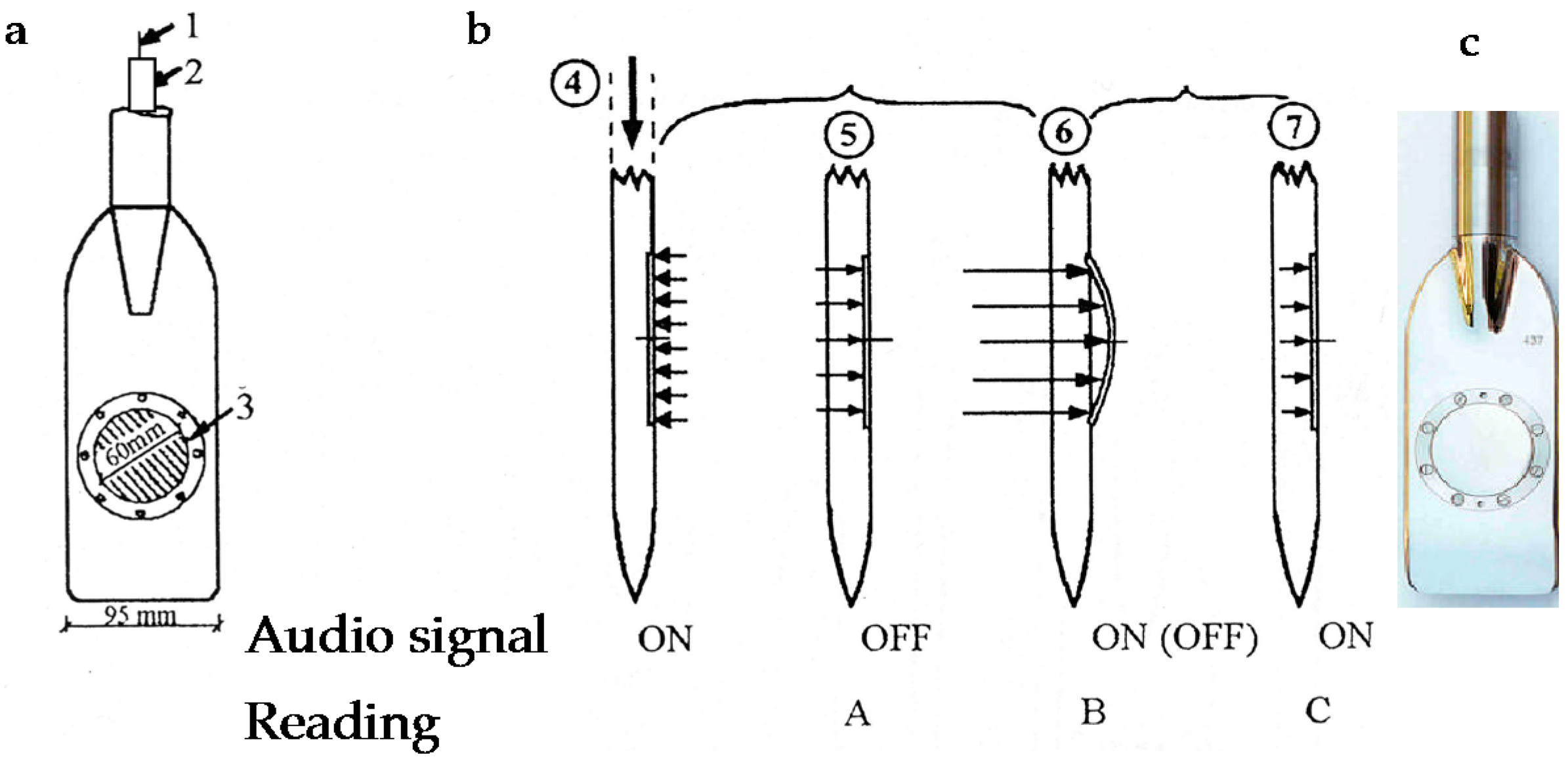
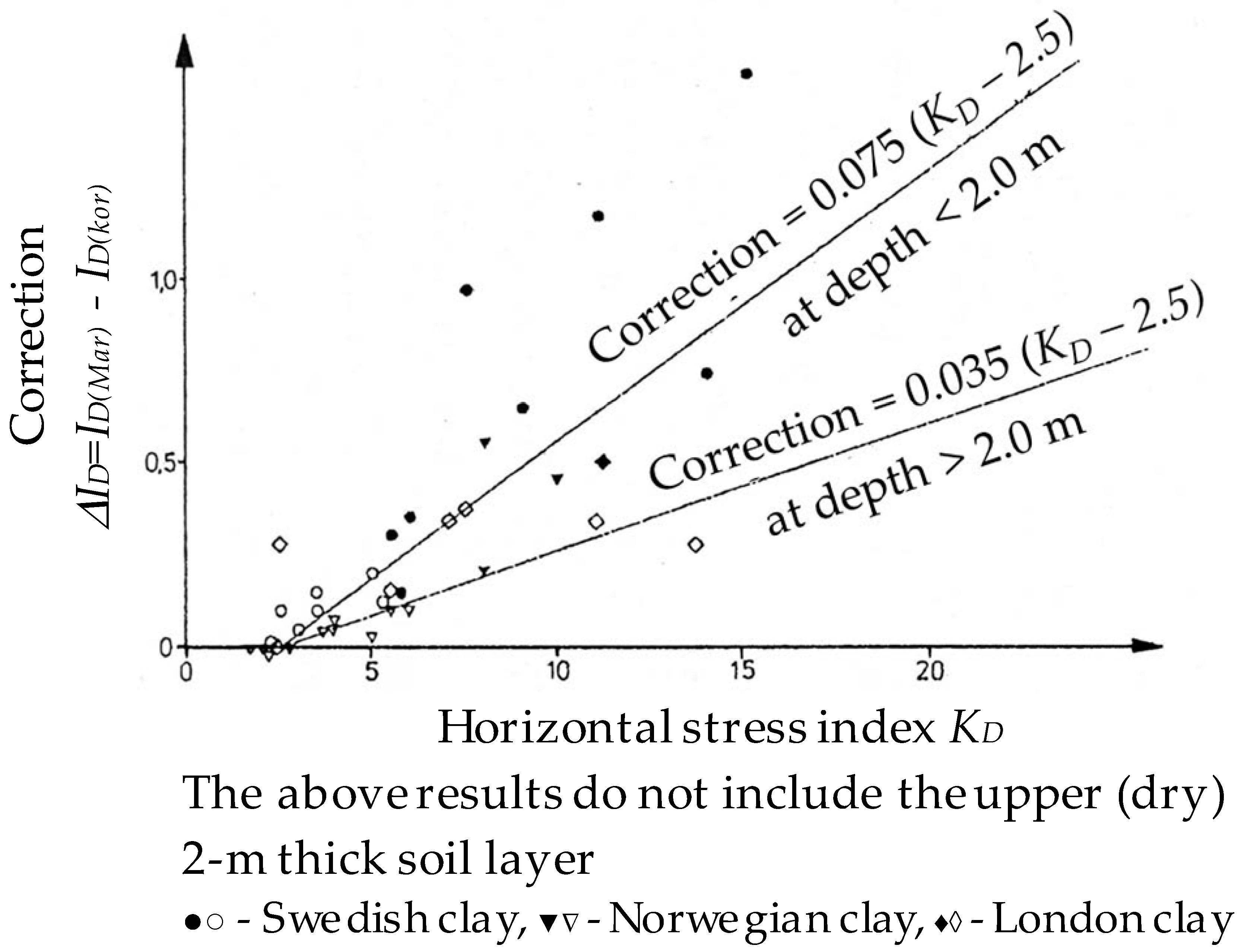
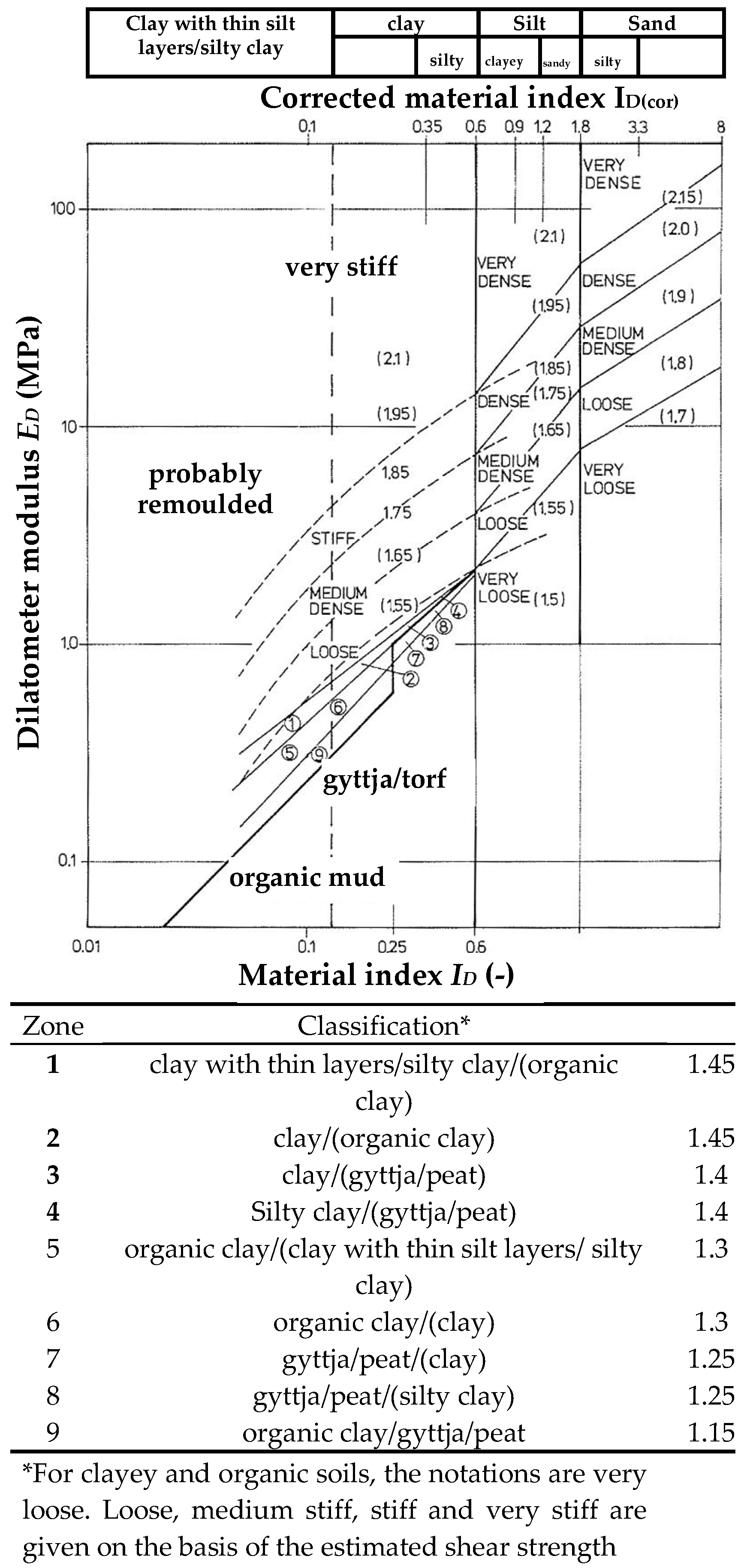

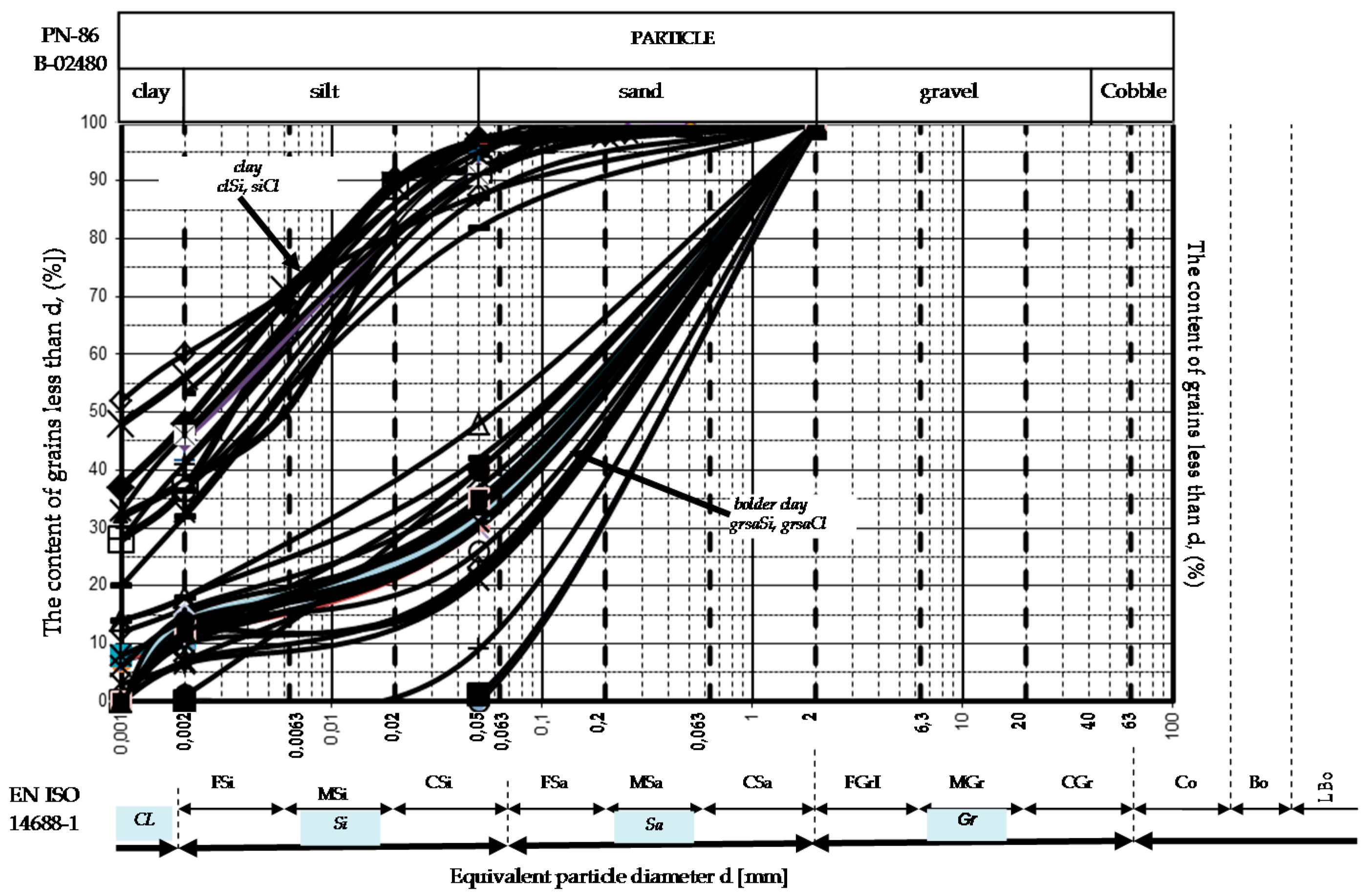




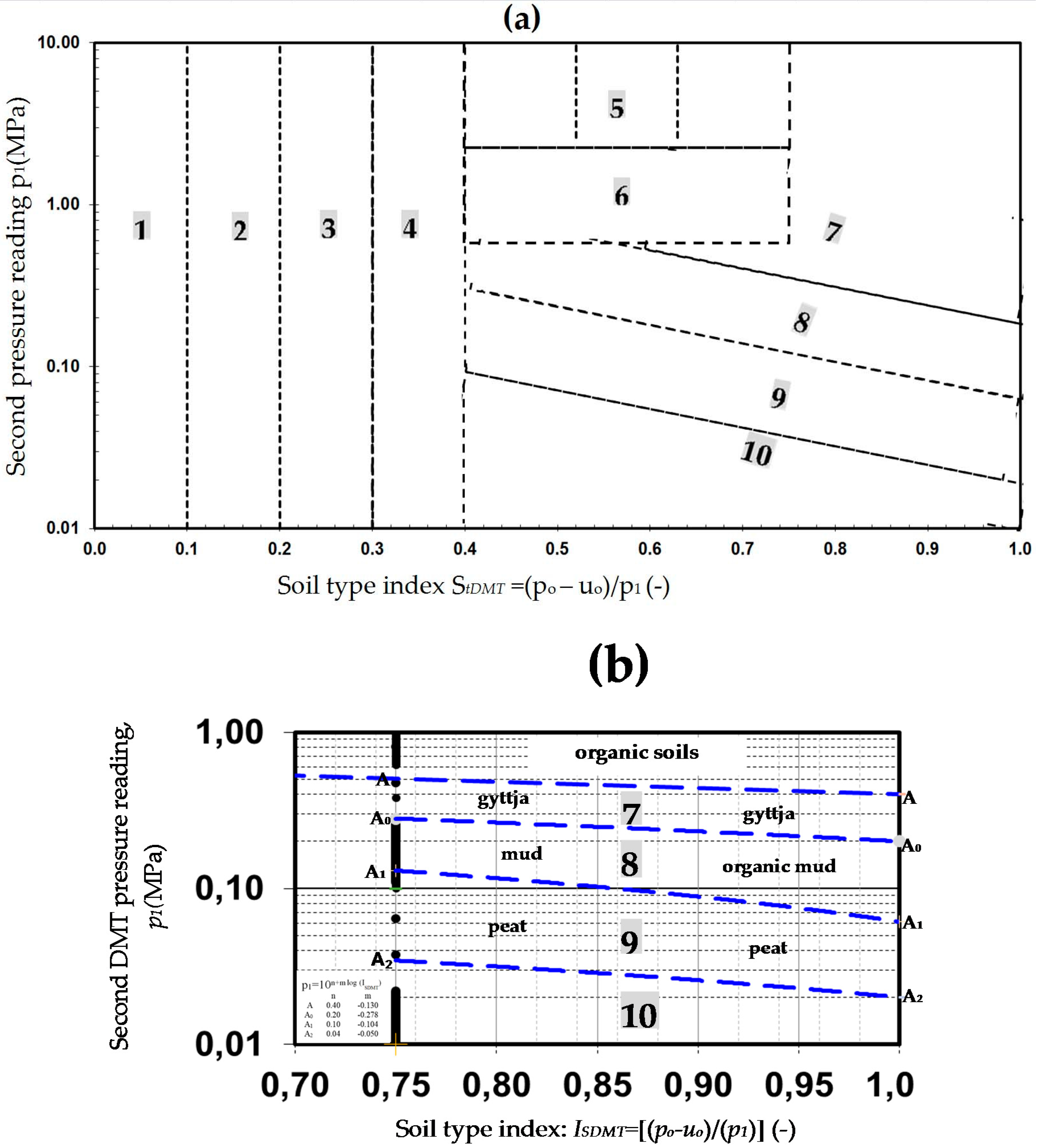

| Soil Type | Material Index ID (-) | |
|---|---|---|
| Organic soils and cohesive soils | Peat/Sensitive clays | <0.10 |
| Clay | 0.10–0.35 | |
| Silty clay | 0.35–0.60 | |
| Clayey silt | 0.60–0.90 | |
| Silt | 0.90–1.20 | |
| Sandy silt | 1.20–1.80 | |
| non-cohesive soils | Silty sand | 1.80–3.30 |
| Sand | >3.30 | |
| Description of Soil State | Undrained Shear Strength τfu [kPa] |
|---|---|
| Very soft | <12.5 |
| Soft | 12.5–25 |
| firm | 25–50 |
| Stiff | 50–100 |
| Very stiff | 100–200 |
| Hard | >200 |
| Site | Type of Soil | Organic Content Iom [%] | CaCO3 Content [%] | Water Content wn [%] | Liquid Limit wL [%] | Density | |
|---|---|---|---|---|---|---|---|
| Unit Weight of Soil ρ [t/m3] | Specific Weight of Soil ρs [t/m3] | ||||||
| Antoniny | amorphous Peat | 65–75 | 10–15 | 310–340 | 305–450 | 1.05–1.10 | 1.45–1.50 |
| calcareous Gyttja | 5–20 | 65–90 | 105–140 | 80–110 | 1.25–1.40 | 2.2–2.30 | |
| Koszyce | amorphous Peat | 70–85 | 5–15 | 400–550 | 450 | 1.05–1.1 | 1.45–1.50 |
| calcareous Gyttja (Gy) | 10–20 | 65–80 | 120–160 | 80–110 | 1.20–1.35 | 2.1–2.25 | |
| calcareous Gyttja (Gy) | 15–20 | 65–75 | 180–220 | 100–110 | 1.25–1.30 | 2.2 | |
| Nielisz | Organic mud (Mor) | 20–30 | - | 120–150 | 130–150 | 1.25–1.30 | 2.25–2.3 |
| Organic mud (Mor) | 10–20 | - | 105–120 | 110–130 | 1.30–1.45 | 2.30–2.40 | |
| Stegny | Pliocene clays | - | - | 19.20–28.50 | 67.6–88.0 | 2.1–2.2 | 2.68–2.73 |
| SGGW Campus | Boulder clay | - | - | 5.20–20.10 | 21.9–26.6 | 2.0–2.2 | 2.68–2.73 |
| Zone | Description | ρ (t/m3) | ρd (t/m3) | Void Ratio e (-) | wn (%) | p1 (MPa) | ISDMT (-) | τfu (MPa) from FVT |
|---|---|---|---|---|---|---|---|---|
| Residual mineral soils | ||||||||
| 1 | Coarse sand (CSa) | 1.70 ÷ 2.15 | 1.65 ÷ 2.0 | 0.20 ÷ 0.48 | 4.0 ÷ 25 | 0.2 ˂ p1 ≤ 10 | 0.0 ÷ 0.1 | 0.10 ≤ τfu < 0.30 |
| 2 | Medium sand (MSa) | 1.70 ÷ 2.15 | 1.65 ÷ 2.0 | 0.20 ÷ 0.48 | 4.0 ÷ 25 | 0.2 ˂ p1 ≤ 10 | 0.1 ÷ 0.2 | 0.10 ≤ τfu < 0.30 |
| 3 | Fine sand (Fsa) | 1.70 ÷ 2.15 | 1.60 ÷ 2.0 | 0.20 ÷ 0.48 | 5.0 ÷ 28 | 0.2 ˂ p1 ≤ 10 | 0.2 ÷ 0.3 | 0.10 ≤ τfu < 0.30 |
| 4 | Silty sand(siSa) | 1.70 ÷ 2.15 | 1.59 ÷ 2.0 | 0.20 ÷ 0.48 | 5.0 ÷ 28 | 0.2 ˂ p1 ≤ 10 | 0.3 ÷ 0.4 | 0.10 ≤ τfu < 0.30 |
| 5 | SILT(Si) | 1.60 ÷ 2.10 | 1.4 ÷ 1.90 | 0.18 ÷ 0.70 | 10 ÷ 30 | 2.0 ˂ p1 ≤ 10 | 0.4 ÷ 0.75 | 0.02 ≤ τfu < 0.5 |
| 6 | CLAY(Cl) | 1.60 ÷ 2.10 | 1.50 ÷ 1.70 | 0.18 ÷ 0.40 | 20 ÷ 40 | 0.5 ˂ p1 ≤ 2 | 0.4 ÷ 0.75 | 0.02 ≤ τfu < 0.6 |
| Organic soils | ||||||||
| 7 | Gyttja (Gy) | 1.20 ÷ 1.40 | 0.50 ÷ 0.60 | 2.5 ÷ 3.2; | 110% ÷ 150% | 0.09 ≤ p1 ˂0.2 | 0.40 ˂ ISDMT ≤ 1.0 | 0.0125 ≤ τfu < 0.0255 |
| 8 | Mud (M) or Organic mud (Mor) | 1.25 ÷ 1.70 | 0.54 ÷ 0.67 | 2.6 ÷ 3.2; | 110% ÷ 140% | 0.2 ˂ p1 ≤ 0.5 | 0.0255 ≤ τfu < 0.0505 | |
| 9 | peat | 1.05 ÷ 1.10 | 0.17 ÷ 0.244 | 4.5 ÷ 7.3 | 350% ÷ 500% | p1 ˂ 0.09 | τfu < 0.0125 | |
| 10 | τfu > 0.0125 | |||||||
| Soil Types\Parameters | Residual Mineral Soils | Organic Soils | |||
|---|---|---|---|---|---|
| Non-Cohesive Soils | Cohesive Soils | Gyttja (Gy) | Mud (M) and Organic Mud (Mor) | Peat | |
| ISDMT | 0.0 ˂ ISDMT ≤ 0.4 | 0.4 ˂ ISDMT ≤ 0.75 | 0.4 ˂ ISDMT ≤ 1.0 | ||
| p1 (MPa) | 0.1 ˂ p1 ≤ 10 | 1.0 ˂ p1 ≤ 10 | 0.09 ≤ p1 ˂ 0.2 | 0.2 ˂ p1 ≤ 0.5 | p1 ˂ 0.09 |
© 2018 by the author. Licensee MDPI, Basel, Switzerland. This article is an open access article distributed under the terms and conditions of the Creative Commons Attribution (CC BY) license (http://creativecommons.org/licenses/by/4.0/).
Share and Cite
Rabarijoely, S. A New Approach to the Determination of Mineral and Organic Soil Types Based on Dilatometer Tests (DMT). Appl. Sci. 2018, 8, 2249. https://doi.org/10.3390/app8112249
Rabarijoely S. A New Approach to the Determination of Mineral and Organic Soil Types Based on Dilatometer Tests (DMT). Applied Sciences. 2018; 8(11):2249. https://doi.org/10.3390/app8112249
Chicago/Turabian StyleRabarijoely, Simon. 2018. "A New Approach to the Determination of Mineral and Organic Soil Types Based on Dilatometer Tests (DMT)" Applied Sciences 8, no. 11: 2249. https://doi.org/10.3390/app8112249







